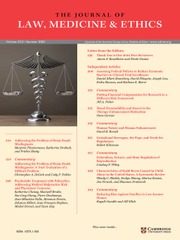Dear Editor,
Please accept this as the authors’ response to the Comment on our recently published paper, “Vaccine Procurement: The Changes Needed to Close Access Gaps and Achieve Health Equity in Routine and Pandemic Settings”,Reference Harmon, Graham and Kholina 1 which interaction we strongly welcome.
We agree with the Commentator that in-depth case studies of particular jurisdictions, and of particular vaccine procurement transactions, would be informative, as they would generate much more granular evidence demonstrating the inequity of the “system” than currently exists, and therefore on the need for procurement reform. As the article we wrote was part of a larger project focused on public health governance more broadly, such additional case studies were beyond the scope of work. Having said that, critiques of specific approaches to vaccine and drug procurement and pricing abound, 2 and some additional sources are referred to in the paper.
We also appreciate the political difficulty of better aligning practices and regulatory approaches across jurisdictions, and we acknowledge that greater fairness and transparency through improved legal or regulatory harmonization is only one component of the program needed to achieve the shift necessary to make access to vaccines (and medicines) more equitable. Many of the ways by which vaccine inequity is preserved and advanced — to the financial boon of private actors — are embedded in the system that is in large part captured by interests and designed to preserve inequalities. To effectively combat those standards, processes, and machinations, multiple courses of action are required — increased transparency and more harmonization practices through legal reform is just one course.
Obviously, the political vision and the perseverance needed to pursue the course mapped out in our paper, together with other potential reforms, will only be realized if the “revolution of values” called for is taken seriously. Fundamental realignment of the legal and social order is the necessary starting point of many/most interventions if they are to be effective or to serve as anything more than band-aids, or placebos. This undeniably requires leadership that is courageous enough and persistent enough to resist the pressure of powerful profit-seeking actors, the inertia of regulatory cultures, and the evolving characteristics of the ‘late capitalist’ era, being globalized, financialized economies and cultures in which all things are commodified, channeled through social media, and consumed.Reference Crary 3
Given the above, while reform could focus on financial mechanisms, such has proved only marginally ameliorative in other settings (e.g., most notably housingReference Byrne and Norris 4), and it fails entirely to address the deeper problems created by the casting of public goods as for-profit commodities. Policymakers need to resist finding new and more ways to shift public money to private actors in a (futile) effort to overcome those actors’ acutely self-interested behavior, or to download costs to already beleaguered end-users. The systemic inequalities that the commentor alludes to are inequalities created by, and built into, the economic/financialized capitalist system which pulled vaccines from the public sphere to the private/commodified sphere in the first place.
While true reform is, as stated by the Commentor, “theoretically interesting” though politically challenging and practically contested — deeply and stoutly contested — that does not negate the pressing need for profound change. Actors with the power to actually realize that change are the ones who need to transform such ideas from theory to reality. For our part, we engage with those actors as opportunities arise.


